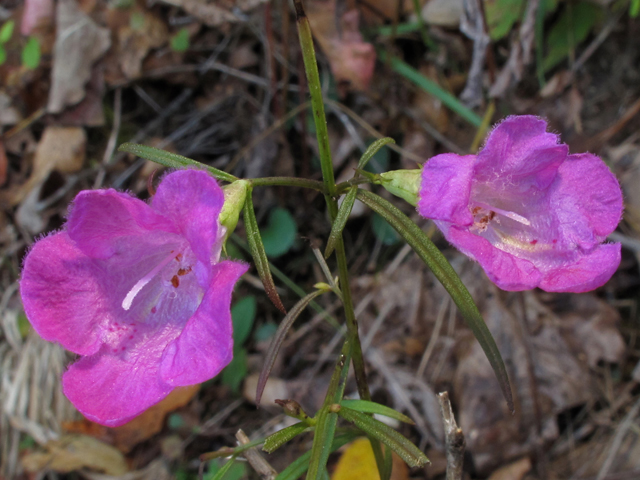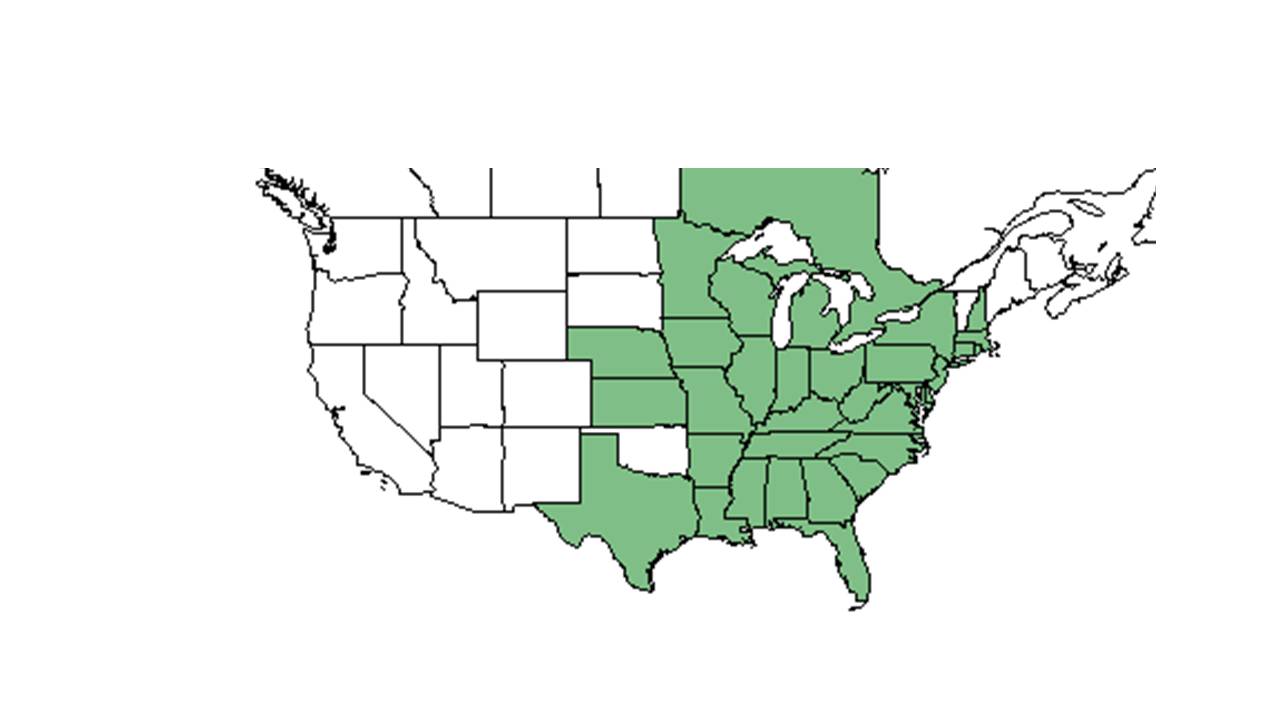Difference between revisions of "Agalinis purpurea"
KatieMccoy (talk | contribs) |
KatieMccoy (talk | contribs) |
||
| Line 44: | Line 44: | ||
Communities are near fire-dependent communities such as longleaf pine/wiregrass communities <ref name="FSU Herbarium"/>. | Communities are near fire-dependent communities such as longleaf pine/wiregrass communities <ref name="FSU Herbarium"/>. | ||
| − | + | ===Pollination=== | |
| − | + | It is visited by bumblebees, digger bees (''Melissodes'' spp.) and leaf cutting bees (''Megachile'' spp.)<ref name="illinois">[[http://www.illinoiswildflowers.info/prairie/plantx/pf_foxglovex.htm]]Illinois Wildflowers. Accessed: March 22, 2016</ref>. | |
| − | < | + | ===Use by animals===<!--Herbivory, granivory, insect hosting, etc.--> |
| + | Caterpillars of the butterfly ''Junonia coenia'' (Buckeye) feed on the foliage<ref name="illinois"/>. | ||
| + | ===Diseases and parasites=== | ||
| + | ''A. purpurea'' is a hemiparasitic species capable of extracting sugars and proteins from a host, along with surviving without a host by preforming photosynthesis<ref name="riopel">Riopel, J. L. and L. J. Musselman (1979). "Experimental Initiation of Haustoria in Agalinis purpurea (Scrophulariaceae)." American Journal of Botany 66(5): 570-575.</ref>. In the absence of a host, it grows autotropically and can complete its lifecycle without a host. When a host is present, reception of chemical signals enable the parasitic mode causing root elongation to slow and accelerated growth of haustorium. Haustorium are not present unless a host is present<ref name="vance">Wm. Vance, B. and J. L. Riopel (1984). "Experimental Studies of Haustorium Initiation and Early Development in Agalinis purpurea (L.) Raf. (Scrophulariaceae)." American Journal of Botany 71(6): 803-814.</ref>. | ||
<!--==Conservation and Management==--> | <!--==Conservation and Management==--> | ||
<!--==Cultivation and restoration==--> | <!--==Cultivation and restoration==--> | ||
Revision as of 10:45, 22 March 2016
| Agalinis purpurea | |
|---|---|

| |
| Photo by Alan Cressler | |
| Scientific classification | |
| Kingdom: | Plantae |
| Division: | Magnoliophyta - Flowering plants |
| Class: | Magnoliopsida - Dicotyledons |
| Order: | Lamiales |
| Family: | Orobanchaceae |
| Genus: | Agalinis |
| Species: | A. purpurea |
| Binomial name | |
| Agalinis purpurea (L.) Pennell | |

| |
| Natural range of Agalinis purpurea from USDA NRCS Plant database. | |
Common names: smooth gerardia or purple false foxglove
Contents
Taxonomic notes
Synonyms: A. purpurea var. purpurea; Gerardia purpurea var. purpurea; Gerardia purpurea Linnaeus; A. purpurea
Description
Annual. Parasitic to the roots of grasses and other herbs. Leaves are opposite, linear to filiform, and sometimes will have tufts on the shoots. Flowers are showy, in terminal racemes; the calyx is 5-parted, the lobes are shorter than the tube; the corolla is 5-parted. The flowers are rose-lavender in color and are rarely white. There are usually 2 yellow lines and numerous purple spots in the throat on the tube. The tube is broad, campanulate, and the lobes are shorter than the tube. The throat is usually lanose at the base of the 2 upper corolla lobes. There are 4 stamens, didynamous, that include filaments and anthers that are also lanose. The stigmas are elongated. The capsules are globose or subglobose, loculicidal [1].
Stems are puberulent or scaberulous and are striate-angled, growing up to 4-12cm tall. It is profusely branched form the upper half to 2/3 of the stem, the branches are spreading. The leaves are opposite and is rarely weakly fascicled. The leaves are linear to narrowly linear-lanceolate, and are often curled, 1-4cm long, 0.5-2mm wide, and is hispidulous above. The terminal racemes indistinct. The pedicels are 1-4mm long, and are usually shorter than the calyx tube or sometimes equaling the size of the calyx tube. The calyx tube is 3-4mm long, truncate or nearly so. The lobes are reduced to minute with subulate teeth being 0.3-2mm long. The corolla is 1.8-3.8cm long and puberulent. The throat of the corolla is lined with yellow and has purple spots. The corolla is lanose at the base of the 2 upper corolla lobes. The capsules are subglobose and are 4-6mm long or broad. Flowers in August until frost [1].
Distribution
It is frequent in all of Florida. Found from west to Texas, north to Massachusetts [2].
Ecology
Habitat
Agalinis purpurea is found in low, wet, sandy or peaty areas such as stream sides and moist depressions within frequently burned pine communities; seepage slopes, fresh water marshes, cypress flats, and hardwood swamps. It also occurs on shallow limerock soils of slash pine rocklands in South Florida, as well as in high, well drained sandhills (Entisols). It occurs primarily in high light conditions, although it can also occur in relatively shaded habitats such as cypress and hardwood swamps [3]. It is tolerant of high densities of grass and sedges such as in pitcher plant bogs and marshes.
The soil tolerance of A. purpurea is wide, including peat (Histosols), loams (Ultisols), and deep sands (Entisols and Spodosols). It also can be found alongside roads, bordering flatwoods, powerline corridors, and other disturbed areas. This species is typically found in full light locations [3].
Associated species include Pine species, Quercus species, Titi, Panicum, Hyptia, Eriocaulon, Aletris, and others. Seen among grasses in bogs [3].
Phenology
It flowers from April to November, primarily in October, and fruits from May to November [3].
Seed bank and germination
Agalinis purpurea was absent from the seed bank of ephemeral ponds in Hyannis though they were present as adults. The composition of the seed bank often predicts the future composition of plants after the disturbance of water level drawdown [4].
Fire ecology
Communities are near fire-dependent communities such as longleaf pine/wiregrass communities [3].
Pollination
It is visited by bumblebees, digger bees (Melissodes spp.) and leaf cutting bees (Megachile spp.)[5].
Use by animals
Caterpillars of the butterfly Junonia coenia (Buckeye) feed on the foliage[5].
Diseases and parasites
A. purpurea is a hemiparasitic species capable of extracting sugars and proteins from a host, along with surviving without a host by preforming photosynthesis[6]. In the absence of a host, it grows autotropically and can complete its lifecycle without a host. When a host is present, reception of chemical signals enable the parasitic mode causing root elongation to slow and accelerated growth of haustorium. Haustorium are not present unless a host is present[7].
References and notes
- ↑ 1.0 1.1 Radford, Albert E., Harry E. Ahles, and C. Ritchie Bell. 1964, 1968. Manual of the Vascular Flora of the Carolinas. The University of North Carolina Press. 960 pp. Print.
- ↑ Hall, David W. 1993. Illustrated Plants of Florida and the Coastal Plain: based on the collections of Leland and Lucy Baltzell. A Maupin House Book. Gainesville. 342 pp. Print.
- ↑ 3.0 3.1 3.2 3.3 3.4 Florida State University Robert K. Godfrey Herbarium database. URL: http://herbarium.bio.fsu.edu. Last accessed: June 2014. Collectors: Loran C. Anderson, Robert K. Godfrey, John Morrill, J. M. Canne, Grady W. Reinert, O. Lakela, P. Genelle, G. Fleming, A. H. Curtiss, Duval, John C. Semple, L. Brouillet, Wilson Baker, Jane Brockmann, and J. Ferborgh. States and Counties: Florida: Franklin, Wakulla, Leon , Taylor, Bay, Jefferson, Nassau, Collier, Citrus, Putnam, Monroe, Dade, and Jackson. Georgia: Thomas.
- ↑ Neill, C., M. O. Bezerra, et al. (2009). "Distribution, species composition and management implications of seed banks in southern New England coastal plain ponds." Biological Conservation 142: 1350-1361.
- ↑ 5.0 5.1 [[1]]Illinois Wildflowers. Accessed: March 22, 2016
- ↑ Riopel, J. L. and L. J. Musselman (1979). "Experimental Initiation of Haustoria in Agalinis purpurea (Scrophulariaceae)." American Journal of Botany 66(5): 570-575.
- ↑ Wm. Vance, B. and J. L. Riopel (1984). "Experimental Studies of Haustorium Initiation and Early Development in Agalinis purpurea (L.) Raf. (Scrophulariaceae)." American Journal of Botany 71(6): 803-814.